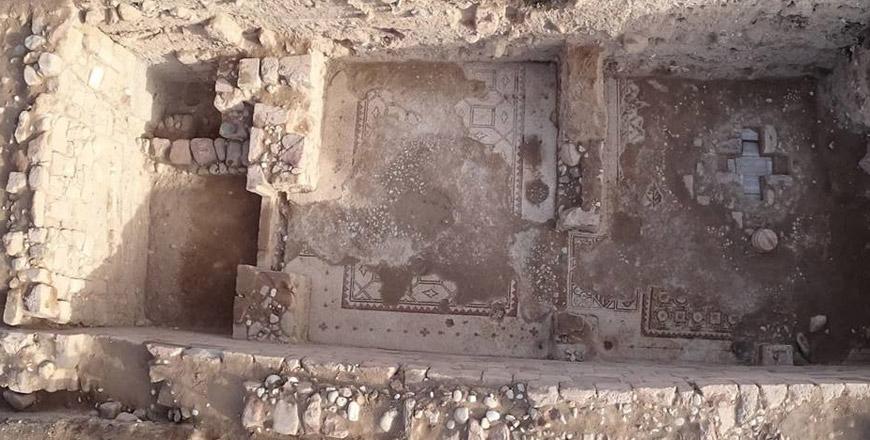You are here
Travelling through time: From the Neolithic Period to contemporary historical phases
By Saeb Rawashdeh - Jun 23,2024 - Last updated at Jun 23,2024

Sique Al Barid steps in Beidha, a few kilometres north of Petra (Photo courtesy of ACOR)
AMMAN — Beidha is a Neolithic site a few kilometres north of Petra and represents a significant location not only during prehistory, but in the later occupational periods. The site is included in the World Heritage Sites with Petra and beside the Neolithic village, Beidha has structures from the Nabataean, Byzantine, Islamic and Crusade periods.
The exact date for the beginning of the occupation of the site is estimated from 7200 to 6500BC. Beidha, although not that popular as Petra, represents one of the oldest villages in the human history. The prehistoric site was occupied and abandoned due to various circumstances that researchers try to decipher and the settlement was rebuilt multiple times.
However, the remains of the prehistoric village are visible and available for tourists to visit.
Beidha represents a site where the first transitions from semi-settled nomads to settled villagers and the start of an agrarian economy took place. At the Beidha Neolithic site, one can see like in a timecapsule what the Neolithic dwellings may have looked like
The site was excavated in the 1950’s and 1960’ by Diana Kirkbride, a British archaeologist, and is located within the protected area of the Petra Archaeological park.
During the Neolithic period, hunters and gatherers lived seasonally in this fertile, cooler and sheltered area. The first agriculture and herding were practices by inhabitants of Beidha.
However, the site was significant place in the later historical stages and some of these structures had the multiple use.
One of such buildings is a Nabataean Hall that was reused in the Byzantine era and later on during Crusades as a church.
According to Professor of Archaeology specialised in Classical Architecture from the University of Athens Chrysanthos Kanellopoulos,” very little of the original Nabataean facade remained. There was no evidence of a bench so this hall may not have been a triclinium, but was perhaps a residence.”
In the Byzantine era, an apse was cut into the eastern wall of the structure and a bishop’s chair was configured within that and on either side of the chair were steps for other clergy to stand, Kanellopoulos elaborated. The structure was excavated down to bedrock in only a few places and no trace of the altar was found.
Furthermore, Bishop’s chairs are well known in Petra; such installations become common in the late 6th century AD while a votive niche was cut into the area south of the bishop’s chair.
“One other feature can be deduced from incisions in the walls: There was a polycandelon with a system to raise andon the eastern wall of the building, there was an inscription [infra] and another niche,” Kanellopoulos said, adding that the southern wall of the church consisted of walls 111 and 113 with a door at the centre.
Beyond wall 111 there was a three-story structure built with arches; two sets of arch springers cut into the bedrock of the eastern wall are still visible, the professor explained, adding that the structure probably contained a sacristy on the ground floor and private quarters, perhaps including bedrooms or cubicula (a small room provided in catacomb).
“The corresponding western end of the church facade probably had windows. It is possible that this church continued its use into the Crusader era; alternately, it is also possible that it was abandoned for a time and then used again in that period. It should be noted that there are a multitude of small crosses carved into the eastern wall to the north of the apse,” Kanellopoulos underlined, adding that southwest of the church is a structure that has graffiti carved into it.
In the later centuries after Crusades, the building decayed and was used as a pen for animals.
“The two crude stone constructions against the northern wall were perhaps to store animal fodder, and it shows the entry partially closed with stones. Use as an animal pen continued until the time of this excavation,” Kanellopoulos noted, adding that ancient coins were discovered there.
Each of three coins testify about the period of the structure: A coin of the Nabataean King Aretas IV (8BC-1.5AD), a Byzantine coin from the 6th century AD and an Islamic coin.
Related Articles
AMMAN — The Islamic Beidha Project was launched in 2014, under the direction of Italian archaeologist Micaela Sinibaldi, to conduct excavati
AMMAN — Modern Ghor Safi, located at the southeastern end of the Dead Sea near the lowest point on earth, has been populated for over 12,000
AMMAN — Between 1997 and 2013, the Finnish Jabal Haroun Project (FJHP) has carried out archaeological excavations at a Byzantine monastery l














